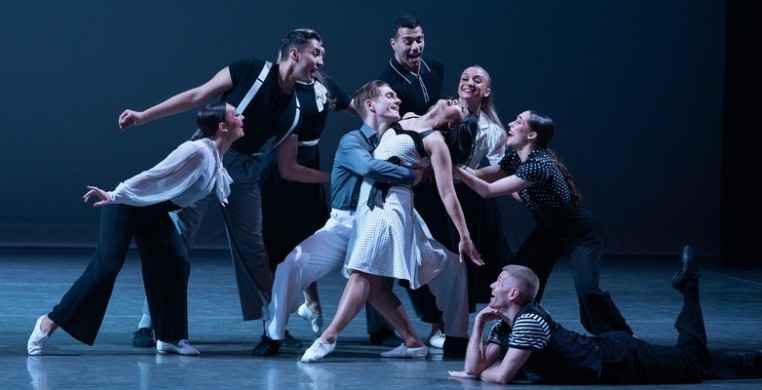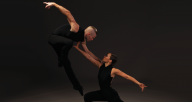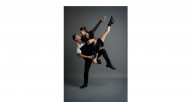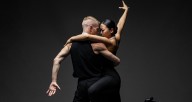The name Gus Giordano is synonymous with jazz dance, as composer George Gershwin is to jazz music. Both Giordano and Gershwin were pioneers in their fields, bringing liveliness, excitement, and a daring boldness to their works. Not only did Giordano codify his own jazz dance technique but he also wrote the renowned Anthology of American Jazz Dance (1976), still in use today. Students of jazz dance have been affected by his foundational teachings for decades.
Gershwin's music was instrumental in shaping the way jazz was received and defined in America, and without his influence much of the music we listen to today would be lost. As Gershwin's most famous and insurmountable work, "Rhapsody In Blue", celebrates its 100 year anniversary, there is no dance company better to honor its legacy than Giordano Dance Chicago (GDC).
GDC premiered two new works at the Harris Theater for Music and Dance this past Friday evening along with a trio of familiar repertoire. The company unveiled "unconditional", choreographed by company member Adam Houston, and one act performance of "Gershwin In B", choreographed by guest Al Blackstone. The live performances were perforated by two behind-the-scenes videos, and throughout the evening the company received numerous standing ovations from the audience, which included founding members of GDC.
Act one was composed of four GDC works: "Entropy" (2002), "Sing Sing Sing" (1983), "unconditional" (2024), and "SOUL" (2018). Each work offered a different vantage point into the skill set of the GDC ensemble. "Entropy" showed off the diverse technical skills required to perform a work embedded with classical modern, contemporary ballet, african, and street jazz stylings. Both "SOUL" and "Sing Sing Sing" demonstrated GDC's commitment to exemplary jazz dance, with the latter exhibiting the classic Giordano Technique and choreography. Although slated as a jazz dance company, GDC is truly diverse in their craft, giving the audience a well-curated evening featuring many facets of concert dance.
 Sasha Lazarus and Fernando Rodriguez in the World Premiere of Adam Houston's "unconditional"; Photo by Anderson Photography
Sasha Lazarus and Fernando Rodriguez in the World Premiere of Adam Houston's "unconditional"; Photo by Anderson Photography
Rehearsal captain Adam Houston's new work "unconditional" was met with exuberant applause from the audience. The pas de deux, exquisitely danced by Sasha Lazarus and Fernando Rodriguez, featured a love story told through seamless partner work and tender embrace. The choreography, a departure from the classic jazz vernacular of the company, exhibited Houston's ability to translate a tale as old as time romance, into a contemporary ballet dance that evoked a serene aura throughout the audience. Hopefully in the future we will be treated to more of Houston's creative work, including an expanded version of "unconditional".
Act II began with a prelude video, featuring rehearsal footage and interviews with dancers and choreographer Al Blackstone. This short teaser furthered the anticipatory energy that was abuzz in the Harris Theater. Although the 100-year anniversary of "Rhapsody In Blue" was the catalyst of the project, the work was filled with various Gershwin arrangements, including "Embraceable You" (1928), "But Not For Me" (1930), and a recurring theme from "They Can't Take That Away From Me" (1937). Blackstone's penchant for storytelling through dance took the viewer on a journey of one woman, brought to life by Erina Ueda as she encounters life and embraces its curiosities and wonders.
GDC's performance of "Gershwin In B" encapsulates the definition of a rhapsody: a composition that is irregular in form and is an ecstatic expression of feeling or enthusiasm. Dancers moved across the stage with the buoyancy and finesse that GDC is known for. They pulled their audience into a familiar world, allowing them to feel the vast range of emotions, such as despair, passion, fervor, and gumption, that make up the experience of living.
 GDC in the World Premiere of Al Blackstone's "Gershwin in B"; Photo by Anderson Photography
GDC in the World Premiere of Al Blackstone's "Gershwin in B"; Photo by Anderson Photography
With familiar scenes, such as a party featuring red cups or a bumpy train ride, a woman embraces life around her as she continues to be enticed by a red fedora hat, puppeteered on stage by both invisible strings and the ensemble. While the significance of the red hat is not directly identified, the woman's desire to grab hold of it is clearly indicated through the unmistakable perseverance Ueda portrays.
As she continues to encounter new experiences by opening and entering through doors, portrayed by the dancers in the cast, we are taken on a journey in search of the standard American dream, so often represented through various forms.
While Gershwin's music is commonly associated with the classic American fantasy, Blackstone's innovative choreography matched with the charm and artistry of the GDC ensemble creates anything but a typical snapshot of the American dream.




